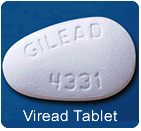Thai
Study Confirms Efficacy of Tenofovir (Viread) Regimens for HIV-HBV Coinfected
Patients By
Liz Highleyman  Due
to overlapping transmission routes, many people
with HIV have also been exposed to hepatitis B
virus (HBV). As the number of people infected with HIV increases in areas
where HBV is endemic, such as southeast Asia, HIV-HBV
coinfection is a growing concern that can complicate treatment for both disease. Due
to overlapping transmission routes, many people
with HIV have also been exposed to hepatitis B
virus (HBV). As the number of people infected with HIV increases in areas
where HBV is endemic, such as southeast Asia, HIV-HBV
coinfection is a growing concern that can complicate treatment for both disease.
Several
approved and experimental anti-HBV drugs -- including tenofovir
(Viread; also in the Truvada
and Atripla coformulations), lamivudine
(3TC; Epivir), emtricitabine (Emtriva),
and, as
recently reported, entecavir (Baraclude)
-- are also active against HIV. Using such agents alone can lead to both viruses
developing resistance. Current
HIV treatment guidelines recommend
that HIV-HBV coinfected individuals who
require therapy for chronic hepatitis B should receive a full HAART
regimen containing dually active NRTIs. As
reported in the October 2008 issue of Hepatology, Gail Matthews and colleagues
conducted a prospective clinical trial to compare anti-HBV monotherapy using lamivudine
or tenofovir versus combination therapy with lamivudine plus tenofovir in HIV-HBV
coinfected individuals in Thailand. A total of 36 coinfected patients initiating
combination antiretroviral therapy for the first time were randomly assigned to
receive either lamivudine, tenofovir, or both as anti-HBV agents within a HAART
regimen.
Results
•
At week 48, the median HBV DNA reductions from baseline were 4.07 log10 copies/mL
in the lamivudine arm, 4.57 log10 copies/mL in the tenofovir arm, and 4.73 log10
copies/mL in the lamivudine + tenofovir arm (P = 0.70).
•
In an intent-to-treat analysis, HBV DNA viral load was suppressed to < 3 log10
copies/mL in 46% of patients in the lamivudine arm, 92% in the tenofovir arm,
and 91% in the lamivudine + tenofovir arm (P = 0.013).
•
HBV resistant mutations were detected in 2 participants, both in the lamivudine
arm.
•
Hepatitis B "e" antigen (HBeAg) loss was observed in 33% of HBeAg positive
patients and 8% experienced hepatitis B surface antigen (HBsAg) loss.
•
Hepatic flares were observed in 25% of study participants.
Lamivudine
monotherapy resulted in a greater proportion of subjects with HBV DNA > 3 log10
copies/mL at week 48 and in early resistance development, the study authors concluded.
"This study confirms current treatment guidelines that recommend
a tenofovir-based regimen as the treatment of choice for HIV-HBV coinfection,
but does not demonstrate any advantage of HBV combination therapy in this short-term
setting," they wrote.
National Centre in HIV Epidemiology and Clinical
Research, University of New South Wales, Sydney, Australia; HIV-Netherlands Australia
Thailand Red Cross AIDS Research Centre, Bangkok, Thailand; Alfred Hospital, Melbourne,
Australia; Department of Medicine, Monash University, Melbourne, Australia; Chulalongkorn
University, Bangkok, Thailand; Victorian Infectious Diseases Service, Royal Melbourne
Hospital, Melbourne, Australia; Victorian Infectious Diseases Reference Laboratory,
Melbourne, Australia. 10/14/08 Reference
GV
Matthews, A Avihingsanon, SR Lewin, and others. A randomized trial of combination
hepatitis B therapy in HIV/HBV coinfected antiretroviral naive individuals in
Thailand. Hepatology 48(4): 1062-1069. October 2008. (Abstract). |

 Due
to overlapping transmission routes, many
Due
to overlapping transmission routes, many